Related Research Articles
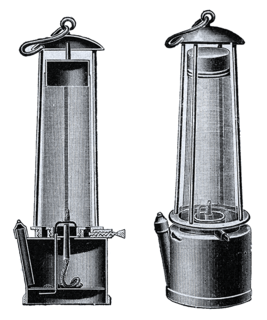
The Davy lamp is a safety lamp for use in flammable atmospheres, invented in 1815 by Sir Humphry Davy. It consists of a wick lamp with the flame enclosed inside a mesh screen. It was created for use in coal mines, to reduce the danger of explosions due to the presence of methane and other flammable gases, called firedamp or minedamp.

The World's Columbian Exposition was a world's fair held in Chicago in 1893 to celebrate the 400th anniversary of Christopher Columbus' arrival in the New World in 1492. The centerpiece of the Fair, held in Jackson Park, was a large water pool representing the voyage Columbus took to the New World. Chicago had won the right to host the fair over several other cities, including New York City, Washington, D.C., and St. Louis. The exposition was an influential social and cultural event and had a profound effect on American architecture, the arts, American industrial optimism, and Chicago's image.

Artificial lighting technology began to be developed tens of thousands of years ago and continues to be refined in the present day.

The Great Exhibition of the Works of Industry of All Nations, also known as the Great Exhibition or the Crystal Palace Exhibition, was an international exhibition which took place in Hyde Park, London, from 1 May to 15 October, 1851. It was the first in a series of World's Fairs, exhibitions of culture and industry that became popular in the 19th century. The event was organised by Henry Cole and Prince Albert, husband of Victoria, Queen of the United Kingdom.

The Science Museum is a major museum on Exhibition Road in South Kensington, London. It was founded in 1857 and to date is one of the city's major tourist attractions, attracting 3.3 million visitors annually.

The Ideal Home Show is an annual event in London held at Olympia, London. The show was devised by the Daily Mail newspaper in 1908 and continued to be run by the Daily Mail up until 2009. It was then sold to events and publishing company Media 10.
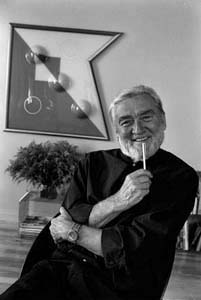
Verner Panton is considered one of Denmark's most influential 20th-century furniture and interior designers. During his career, he created innovative and futuristic designs in a variety of materials, especially plastics, and in vibrant and exotic colors. His style was very "1960s" but regained popularity at the end of the 20th century. As of 2004, Panton's best-known furniture models are still in production.

Pavel Nikolayevich Yablochkov was a Russian electrical engineer, businessman and the inventor of the Yablochkov candle and the transformer.

Imperial War Museum North is a museum in the Metropolitan Borough of Trafford in Greater Manchester, England. One of five branches of the Imperial War Museum, it explores the impact of modern conflicts on people and society. It is the first branch of the Imperial War Museum to be located in the north of England. The museum occupies a site overlooking the Manchester Ship Canal on Trafford Wharf Road, Trafford Park, an area which during the Second World War was a key industrial centre and consequently heavily bombed during the Manchester Blitz in 1940. Just across the Trafford Wharf Road from the Museum is the bulk of the Rank Hovis Flour Mill, a survivor from a former industrial age and now rather out of keeping with the surrounding architecture. The area is now home to the Lowry cultural centre and the MediaCityUK development, which stand opposite the museum at Salford Quays.

Beamish Museum is the first regional open-air museum, in England, located at Beamish, near the town of Stanley, in County Durham, England. Beamish pioneered the concept of a living museum. By displaying duplicates or replaceable items, it was also an early example of the now commonplace practice of museums allowing visitors to touch objects.

Crufts is an international dog show held annually in the United Kingdom, first held in 1891. Organised and hosted by The Kennel Club, it is the largest show of its kind in the world.

Gas lighting is the production of artificial light from combustion of a gaseous fuel, such as hydrogen, methane, carbon monoxide, propane, butane, acetylene, ethylene, coal gas or natural gas. The light is produced either directly by the flame, generally by using special mixes of illuminating gas to increase brightness, or indirectly with other components such as the gas mantle or the limelight, with the gas primarily functioning as a heat source for the incandescence of the gas mantle or lime.
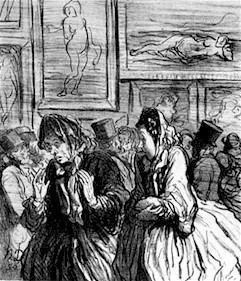
An art exhibition is traditionally the space in which art objects meet an audience. The exhibit is universally understood to be for some temporary period unless, as is rarely true, it is stated to be a "permanent exhibition". In American English, they may be called "exhibit", "exposition" or "show". In UK English, they are always called "exhibitions" or "shows", and an individual item in the show is an "exhibit".

The Society for the Encouragement of Arts, Manufactures and Commerce held the first modern public exhibition on 21 April 1760 in London. It would be the first in a series of fine art exhibitions held by the institution later known as the Society of Arts. Prizes were offered for improvements in the manufacture of tapestry, carpets and porcelain, and winners were chosen from a competition of submitted articles. The show was open to society members and their friends.
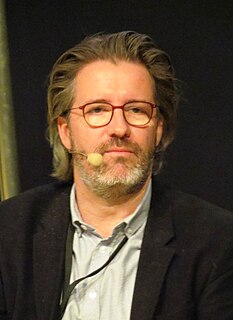
Olafur Eliasson is an Icelandic–Danish artist known for sculptured and large-scale installation art employing elemental materials such as light, water, and air temperature to enhance the viewer's experience. In 1995 he established Studio Olafur Eliasson in Berlin, a laboratory for spatial research. In 2014, Eliasson and his long-time collaborator, German architect Sebastian Behmann founded Studio Other Spaces, an office for architecture and art. Olafur represented Denmark at the 50th Venice Biennale in 2003 and later that year installed The Weather Project, which has been described as "a milestone in contemporary art", in the Turbine Hall of Tate Modern, London.

Empire Exhibition, Scotland 1938 was an international exposition held at Bellahouston Park in Glasgow, from May to December 1938.
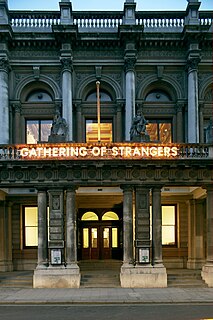
Nathan Coley is a contemporary British artist who was shortlisted for the Turner Prize in 2007 and has held both solo and group exhibitions internationally, as well as his work being owned by both private and public collections worldwide. He studied Fine Art at Glasgow School of Art between 1985 and 1989 with the artists Christine Borland, Ross Sinclair and Douglas Gordon amongst others.

The British Institution was a private 19th-century society in London formed to exhibit the works of living and dead artists; it was also known as the Pall Mall Picture Galleries or the British Gallery. Unlike the Royal Academy it admitted only connoisseurs, dominated by the nobility, rather than practising artists to its membership, which along with its conservative taste led to tensions with the British artists it was intended to encourage and support. In its gallery in Pall Mall the Institution held the world's first regular temporary exhibitions of Old Master paintings, which alternated with sale exhibitions of the work of living artists; both quickly established themselves as popular parts of the London social and artistic calendar. From 1807 prizes were given to artists and surplus funds were used to buy paintings for the nation. Although it continued to attract members and visitors, in 1867, when the lease on its quarters expired, instead of renewing the society wrapped up its affairs.
The Art Treasures of Great Britain was an exhibition of fine art held in Manchester, England, from 5 May to 17 October 1857. It remains the largest art exhibition to be held in the UK, possibly in the world, with over 16,000 works on display. It attracted over 1.3 million visitors in the 142 days it was open, about four times the population of Manchester at that time, many of whom visited on organised railway excursions. Its selection and display of artworks had a formative influence on the public art collections that were then being established in the UK, such as the National Gallery, National Portrait Gallery and the Victoria and Albert Museum.

Tulip Hysteria Co-ordinating is a fictitious work of art by Marcel Duchamp.
References
This article needs additional citations for verification .(June 2007) |
- 1 2 3 Official Guide and Programme - National Gas Congress and Exhibition. London, available in British Library. 1913.